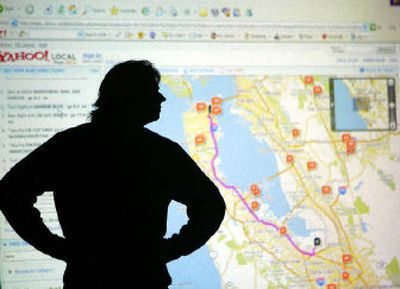More than a map

Editor’s note: This is the second of two stories examining the technology needed to keep up with the demand for digital maps.
NEW YORK — You can pull up satellite and aerial images, discover neighborhood jazz clubs and check the latest traffic conditions. You can even get some rail schedules and, hopefully one day, tips on foot and bike trails through parks.
Digital maps produce so much more than driving directions these days.
And as features get added, mapping companies are having to build better technologies and find better sources of data — including their own users.
Microsoft Corp. is working on a mechanism that would have avid mountain bikers, for example, collectively plot good trails. Yahoo Inc. is appealing to its users to add information on local businesses and places of interest. Yahoo even recently bought Upcoming.org, a collaborative calendar of events.
“More and more data has to become available to provide these kinds of great offerings,” said Jeremy Kreitler, Yahoo’s senior product manager for maps. “These kinds of information will come from people around local areas contributing.”
Online mapping is hot and highly competitive. Nielsen/NetRatings recorded a 28 percent jump in visitors this year, with one-third of Web users visiting at least one mapping site in November.
Microsoft, Yahoo, MapQuest and Google Inc. get their primary data from two companies, Navteq Corp. and Tele Atlas NV, both of which have been aggressively canvassing the nation’s highways and byways to keep their databases complete and accurate.
Data companies are typically paid for each map consumers generate. Christian Dwyer, MapQuest’s director of operations, estimates that driving directions cost his company a penny apiece and a static map much less — expenses recouped through sales of ads displayed at the site.
To set themselves apart, mapping providers must decide individually which of the various attributes provided by Navteq and Tele Atlas to emphasize: Is speed limit more important than distance? Would it make sense to take a highway for just one exit?
MapQuest, for instance, assigns scores to various route alternatives based on number of turns, distance and other factors and, unless you tell its software engine to avoid all highways, it presents the route with the lowest score.
Mapping companies also must decide how much information to provide. Zoom out, and data on local streets only clutter the map even if the information is readily available.
Yahoo employs consumer focus groups to help it figure out the proper balance. It also dispatches motorist guinea pigs onto the road with driving directions, while employees tag along and watch how they fare.
“This is where it’s more art than science,” Kreitler said.
The basics have changed little since MapQuest’s site opened nearly a decade ago, on Feb. 5, 1996. Where mapping providers differentiate themselves, then, is in the distinct features they offer.
Yahoo provides information on subway stations and is testing multiple-point directions, in case someone wants to stop off to buy a gift on the way to a friend’s. Yahoo, along with Microsoft, also provides real-time traffic information for some cities.
Google and Microsoft have satellite imagery from private and government sources. Microsoft also is testing aerial, bird’s-eye-view images and is working to create 3-D maps over Web browsers (Google does these through free software called Google Earth.)
The mapping providers also are working to get their products on mobile devices. And to make their services more useful, they’ve been merging maps with data on local businesses like shops, restaurants and theaters.
All this will require data well beyond what Navteq and Tele Atlas alone can provide.
Microsoft already has bought aerial images from a company called Pictometry International Corp., which provides bird’s eye views, taken at 45 degree angles from four directions. As well, Microsoft is shopping around for altitude data required to create models of city buildings in 3-D.
And as Microsoft tries to fill in coverage gaps outside North America and Western Europe, it is looking for potential vendors in China, Japan and other countries, said Tom Bailey, director of marketing for Microsoft’s mapping products.